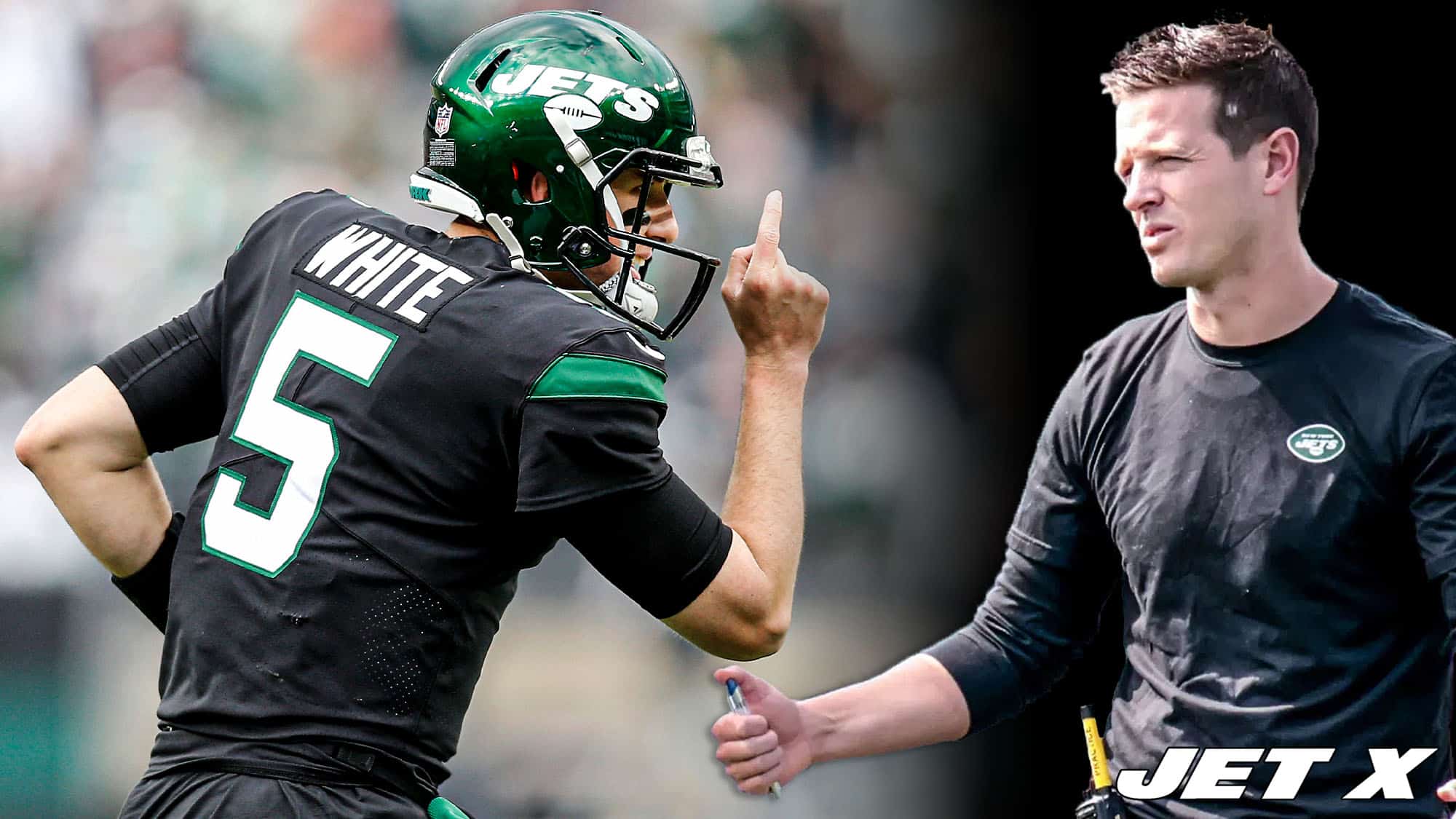Mike LaFleur’s alterations have helped jumpstart the New York Jets offense
The New York Jets offense has turned into somewhat of a juggernaut recently. In back-to-back games, the Jets have posted at least 30 points, 30 first downs, and 480 yards.
Mike White’s insertion into the starting lineup over the injured Zach Wilson is the main change that coincides with the offense’s breakout, but the Jets have also seen some immense growth from their rookie offensive coordinator, Mike LaFleur.
LaFleur began calling plays from up in the coaches’ booth in Week 8 after calling plays from the sidelines over the Jets’ first six games. Since climbing upstairs, LaFleur has made some changes to the offense that have been integral in its improvement.
More screen passes (and better execution on them)
Screen passes were a non-factor in the Jets’ offense over the first six games. New York threw only 19 screens from Weeks 1-7, an average of 3.2 per game.
Those screens were disastrous. They yielded a measly 52 yards, giving them an average of just 2.7 yards per screen play.
LaFleur did not let those ugly results deter him. He has relied upon the screen game even more heavily over the past two games.
The Jets tossed 16 screens from Weeks 8-9, an average of 8.0 per game, more than doubling their previous average. They threw seven against the Bengals and nine against the Colts.
Ultimately, everything comes down to execution. If those screens were producing the same results as before, we would be blasting LaFleur for calling more of them. But they have been working better, so the increased usage looks like a genius decision.
Those 16 screen passes generated 123 yards, an average of 7.7 yards per play.
Everyone deserves some credit for the improved screen-game production. LaFleur is picking better spots to call screens, the players are executing more effectively as blockers, and the receivers are providing more juice with the ball in their hands.
LaFleur recognized that the offense finally found its groove in the screen game and responded accordingly by substantially increasing its usage. Give him credit for holding back on overusing the screen game while it struggled and then going full-throttle with it once it began working.
Better harmony between personnel usage and talent distribution
One of the most common criticisms of LaFleur during the offense’s dark days was his poor utilization of personnel packages. LaFleur was using multi-tight end packages at a high frequency despite the team’s lack of talent at that position and surplus of talent at the wide receiver position.
We are beginning to see LaFleur properly align his personnel usage with the roster’s distribution of talent.
Tight ends are being forced onto the field much less frequently. Over the first seven weeks of the season, LaFleur had the Jets running 12 personnel (1 RB, 2 TE, 2 WR) on 32% of their plays, well above the NFL average of 22%. Over the past two weeks, that number has dipped to 18%.
Accompanying the dip in 12 personnel usage has been a spike in 10 personnel usage (1 RB, 0 TE, 4 WR). After utilizing 10 personnel on just 1% of their plays over the first six games, the Jets have trotted it out on 13% of their plays over the past two.
The NFL average for 10 personnel usage this season is 2%, so the Jets have been using it a ton relative to most other teams – which makes sense given their tremendous depth at wide receiver.
LaFleur is doing a better job of getting the Jets’ best players on the field.
Get Started: Learn More About Becoming A Jet X Member
Kicking play-action to the curb
The Jets’ play-action game was abysmal with Zach Wilson under center. Wilson owns the worst play-action passer rating in the NFL out of 43 qualified quarterbacks (28.1).
LaFleur was calling play-action at a middle-of-the-pack rate while Wilson was playing. Wilson has run play-action on 26.3% of his dropbacks this season, which is just a smidgen below the 2021 league average of 26.8%.
Recently, LaFleur has scrapped the play-action game.
Mike White has run play-action on only 17.6% of his dropbacks, ranking 39th out of 43 qualifiers. Josh Johnson has been asked to run it only 12.0% of the time, the lowest rate out of that 43-player bunch.
Sure, the game flow partially contributes to those low rates – particularly, Johnson was playing catch-up for most of his appearance against the Colts, so play-action wasn’t really an option – but Wilson was playing catch-up for the vast majority of his time on the field, too.
LaFleur has simply removed play-action as a core component of this offense, and it has worked wonders.
Just like the changes he has made to the personnel deployment, LaFleur’s decision to cut down on play-action is a great display of willingness to alter his approach to match the team’s strengths and weaknesses.
The play-action game has still been ineffective with White and Johnson. White is 39th in play-action passer rating (66.0) and Johnson is 37th (82.5).
On the contrary, White has the eighth-best passer rating on non-play-action passes (102.1) while Johnson ranks 11th-best in the same category (99.5).
So, what does LaFleur do? Instead of forcing his philosophy on the players, he alters his philosophy to get the most out of his players.
If your offense is solid without play-action but awful with play-action, lean heavily on the non-play-action game.
Great NFL coaches are able to mold their scheme to fit the players at their disposal. We are starting to see LaFleur master this all-important aspect of coaching.
Audio Version available to members only: Learn more here
Want More NY Jets News & Jets X-Factor Content?
Download the free Jet X Mobile App to get customizable notifications directly to your iOS (App Store) or Google/Android (Google Play) device.
Add Jets X-Factor to your Google News feed to stay up to date with the New York Jets.
Follow us on Twitter @jetsxfactor for all the latest New York Jets news, Facebook for even more, Instagram for some of the top NY Jets images, and YouTube for original Jets X-Factor videos.
Join the official Jets Discord community to connect with likeminded fans.














Michael, you are by far the greatest Jets commentator, I have ever read. Your dedication to breaking down the numbers and providing logical and statistical analysis is supreme. Thank you for all of your hard work. This is the best Jets website on the internet.
Thanks for reading! I appreciate that, means a lot!
Excellent info